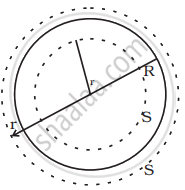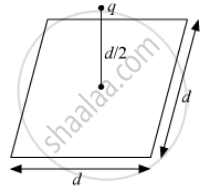Advertisements
Advertisements
Question
Consider a sphere of radius R with charge density distributed as
ρ(r) = kr for r ≤ R
= 0 for r > R
- Find the electric field at all points r.
- Suppose the total charge on the sphere is 2e where e is the electron charge. Where can two protons be embedded such that the force on each of them is zero. Assume that the introduction of the proton does not alter the negative charge distribution.
Solution
a. The symmetry of the problem suggests that the electric field is radial. For points r < R, consider a spherical Gaussian surface. Then on the surface

`oint E_r * dS = 1/ε_0 int_v ρdv`
`4pir^2 E_r = 1/ε_0 4pik int_0^r r^('3) dr^'`
= `1/ε_0 (4pik)/4 r^4`
∴ `E_r = 1/(4ε_0) kr^2`
`E_r = 1/(4ε_0) kr^2 hatr`
For points r > R, consider a spherical Gaussian surfaces’ of radius r,
`oint E_r * dS = 1/ε_0 int_v ρdv`
`4pir^2 E_r = (4pik)/ε_0 int_0^r r^3 dr^`
= `(4pik)/ε_0 R^4/4`
∴ `E_r = k/(4ε_0) R^4/r^2`
`E_((r)) = (k/(4ε_0)) (R^4/r^2)hatr`
b. The two protons must be on the opposite sides of the centre along a diameter. Suppose the protons are at a distance r from the centre.

Now, `4pi int_0^R kr^('3)dr = 2e`
∴ `(4pik)/4 R^4 = 2e`
∴ `k = (2e)/(piR^4)`
Consider the forces on proton 1. The attractive force due to the charge distribution is
`-eE_r = - e/(4ε_0) kr^2 hatr = - (2e^2)/(4piε_0) r^2/R^4 hatr`
The repulsive force is `e^2/(4piε_0) 1/(2r)^2 hatr`
Net force is `(e^2/(4 piε_0 4r^2) - (2e^2)/(4piε_0) r^2/R^4)hatr`
This is zero such that `e^2/(16 piε_0 4r^2) = (2e^2)/(4piε_0) r^2/R^4`
Or, `r^4 = (4R^4)/32 = R^4/8`
⇒ `r = R/(8)^(1/4)`
Thus, the protons must be at a distance `r = R/root(4)(8)` from the centre.
APPEARS IN
RELATED QUESTIONS
Explain why, for a charge configuration, the equipotential surface through a point is normal to the electric field at that point
Obtain the formula for the electric field due to a long thin wire of uniform linear charge density λ without using Gauss’s law. [Hint: Use Coulomb’s law directly and evaluate the necessary integral.]
Electric intensity outside a charged cylinder having the charge per unit length 'λ' at a distance from its axis is ________.
(a) E = `(2pi in_0 lambda)/(Kr^2)`
(b) E = `(in_0 lambda)/(2piKr^2)`
(c) E = `lambda/(2piin_0Kr)`
(d) E = `(4piin_0lambda)/(Kr^2)`
A point charge q is at a distance of d/2 directly above the centre of a square of side d, as shown the figure. Use Gauss' law to obtain the expression for the electric flux through the square.

Use Gauss' law to derive the expression for the electric field `(vecE)` due to a straight uniformly charged infinite line of charge density λ C/m.
State Gauss’Law.
Which statement is true for Gauss law -
Through two parallel wires A and B, 10A and 2A of currents are passed respectively in opposite directions. If the wire A is infinitely long and the length of the wire B is 2m, then force on the conductor B, which is situated at 10 cm distance from A, will be:
The electric field inside a spherical shell of uniform surface charge density is ______.
An infinitely long positively charged straight wire has a linear charge density λ. An electron is revolving in a circle with a constant speed v such that the wire passes through the centre, and is perpendicular to the plane, of the circle. Find the kinetic energy of the electron in terms of the magnitudes of its charge and linear charge density λ on the wire.
